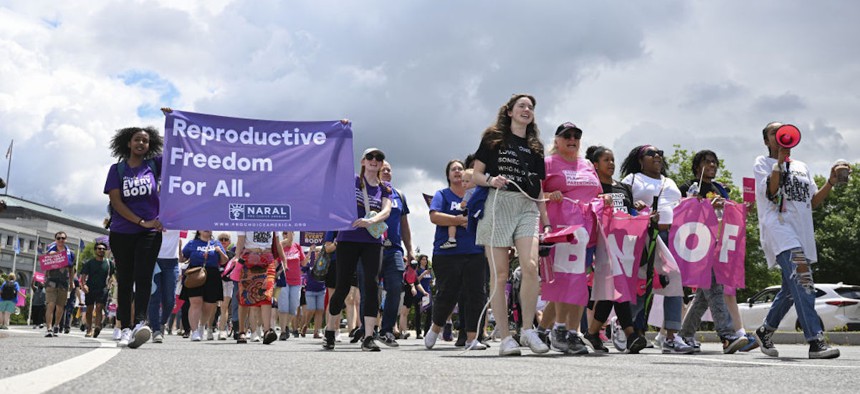Report: Abortions up nationwide post-Dobbs, soared in some states

People gather to protest the first anniversary of the U.S. Supreme Court ruling in the Dobbs v Women's Health Organization case in Columbus Circle in Washington DC. on June 24, 2023. Celal Gunes/Anadolu Agency via Getty Images
Despite some states' attempts to restrict abortion access, the number of abortions have increased nationwide since Roe v. Wade was overturned. Some observers say the rise in patients seeking abortions could put a strain on clinics with limited resources and staff.
This story is republished from Oregon Capital Chronicle. Read the original article.
The number of abortions nationwide increased in the year since the Supreme Court overturned Roe v. Wade, with abortions surging in states including Oregon that don’t limit the procedure, according to a report released Tuesday.
The WeCount report, backed by the Colorado-based Society of Family Planning, is the fourth in a series of quarterly reports tracking abortions each month. It found that there were 2,200 more abortions nationally during the 12-month period from June 2022 to June 2023 than expected based on the monthly average from April and May 2022. The Supreme Court’s ruling in Dobbs v. Jackson Women’s Health Organization came in June 2022.
While the total number of abortions nationwide increased slightly, they were concentrated in states without restrictions. States that border restrictive states had the largest jumps: Illinois is the closest option for many people seeking abortions in the South and Midwest, and 21,500 more abortions occurred in the state this year than would have been expected pre-Dobbs.
“What actually happened during these 12 months is that abortion access plummeted to zero in some states, while increasing to meet the acute need in others, leading to a complete disruption in the health care system and people’s lives,” said Ushma Upadhyay, WeCount co-chair and a professor at the University of California-San Francisco.
The data includes both surgical and medication abortions performed in-person or, in the case of medication abortion, at telehealth clinics. It didn’t draw distinctions between the types of abortions, though previous research indicated that medication accounts for more than half of all abortions.
The report found that about 115,000 fewer clinical abortions happened in the 17 states that have total bans or ban the procedure after six weeks. The most striking decrease was in Texas, which averaged nearly 3,090 abortions each month pre-Dobbs and fewer than 10 each month after the decision. It’s responsible for nearly a third of the total decrease.
In states with less restrictive laws, abortions increased by close to 117,000. Illinois provided more than 21,500 extra abortions over the past year, averaging about 7,300 each month. Pre-Dobbs, about 5,500 abortions occurred in the state each month. Illinois allows abortions through viability around 24-26 weeks, requires insurance to cover the procedure and has a shield law to protect health professionals from investigations by prosecutors in other states.
Megan Jeyifo, executive director of the Chicago Abortion Fund, said her nonprofit organization that supports people seeking abortions has received requests for help from nearly 14,000 people from more than 40 states since the Dobbs decision. The organization has spent $4.5 million helping patients with appointment costs, child care and travel. The Chicago Abortion Fund now has 16 full-time employees, up from two full-time and two part-time workers before the court ruling.
“Our team is nimble, brilliant, compassionate and exhausted,” Jefiyo said. “Barriers to abortion care are not new, but the sheer scale of need and the lengths so many are having to go to access care in this new era are unlike anything we have seen in our close to 40 years of existence.”
Although Florida has restrictive abortion laws – abortions are banned at 15 weeks and patients are required to make at least two trips, one for counseling and one at least 24 hours later for the procedure – it saw a significant increase in abortions, with about 20,000 more than expected over the past year. Reproductive rights advocates in the state are anxiously awaiting a Florida Supreme Court decision on a six-week ban Gov. Ron DeSantis signed earlier this spring.
Amber Gavin, vice-president of advocacy and operations at A Woman’s Choice, an independent abortion clinic with locations in Florida and North Carolina, said she didn’t know where the thousands of people who need abortion care will be able to go. Many clinics are already at capacity, and it can take weeks to get appointments.
“The Dobbs decision has had a devastating effect on the southeast, and it’s only getting worse,” Gavin said. “Until we turn the tide on anti-abortion laws, the situation will only deteriorate for so many people across the country.”
Oregon, which has the nation’s strongest laws protecting abortion, saw a modest increase in the number of abortions over the past year, going from an average of 820 per month pre-Dobbs to 1,017 per month post-Dobbs. The number of abortions in Idaho plummeted from 175 per month to 27 per month, according to the report, with Gem Staters seeking abortions heading to Oregon, Washington, Montana or Wyoming.





